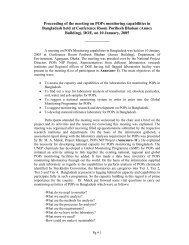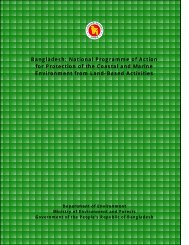Draft CMP HH - the Department of Environment
Draft CMP HH - the Department of Environment
Draft CMP HH - the Department of Environment
Create successful ePaper yourself
Turn your PDF publications into a flip-book with our unique Google optimized e-Paper software.
Coastal and Wetland Biodiversity Management Project BGD/99/G31<br />
Hakaluki Haor <strong>Draft</strong> Conservation Management Plan<br />
• Organise education and awareness raising activities among <strong>the</strong> local community which promote<br />
an understanding <strong>of</strong> <strong>the</strong> need for bird conservation in Hakaluki Haor<br />
• Help raise awareness more widely around <strong>the</strong> nation, as well as internationally about <strong>the</strong> global<br />
significance <strong>of</strong> Hakaluki Haor for migratory birds<br />
• Build <strong>the</strong> capacity <strong>of</strong> local community groups to undertake on-going monitoring <strong>of</strong> bird<br />
populations at Hakaluki Haor<br />
• Ensure that all bird surveys are part <strong>of</strong> an integrated ecological monitoring programme for<br />
Hakaluki Haor<br />
• Review <strong>the</strong> legal and policy framework which regulates <strong>the</strong> protection <strong>of</strong> birds and propose<br />
amendments which more effectively support <strong>the</strong>ir conservation<br />
• Begin identifying ways in which <strong>the</strong> bird populations at Hakaluki Haor can be used as a tourist<br />
attraction for raising revenue to support conservation efforts, as well provide additional sources<br />
<strong>of</strong> income for local communities<br />
Primary Outcome/ Output<br />
• Birds are protected, numbers are increasing, and threatened species are recovered<br />
Constraints<br />
• Enforcement capacity <strong>of</strong> government is weak<br />
• There is likely to be limited human and financial capacity to implement bird species recovery<br />
plans<br />
7.1.2 Wildlife<br />
The wildlife <strong>of</strong> Hakaluki Haor was once represented by a diverse array animal life but rapid habitat<br />
degradation including deforestation, siltation, agricultural encroachment, human habitation and<br />
settlement, and over-harvesting <strong>of</strong> wildlife resources has left <strong>the</strong> ECA with many disappearing and<br />
declining populations and more worryingly <strong>the</strong> complete loss in <strong>the</strong> area <strong>of</strong> some species altoge<strong>the</strong>r.<br />
Although insect life remains relatively abundant, many small mammals, primates, reptiles, and<br />
amphibian species are becoming more and more difficult to observe in <strong>the</strong> ECA; a fact supported by<br />
many local community members. This rapid drop in numbers has resulted in <strong>the</strong> listing <strong>of</strong> over 25<br />
species as vulnerable, endangered, or critically threatened (refer to Table XX list <strong>of</strong> threatened<br />
species above). In some cases, <strong>the</strong> problem is exacerbated by a lack <strong>of</strong> knowledge whereby local<br />
villagers will, for example, indiscriminately kill a snake fearing that it might be poisonous whereas,<br />
in fact, many species found in <strong>the</strong> ECA are relatively harmless.<br />
To prevent <strong>the</strong> loss and fur<strong>the</strong>r decline <strong>of</strong> wildlife species in <strong>the</strong> ECA, <strong>the</strong> initiation <strong>of</strong> urgent<br />
conservation activities are now a necessity.<br />
Management Actions<br />
• Undertake, in collaboration with local community groups, a comprehensive survey <strong>of</strong> wildlife in<br />
<strong>the</strong> ECA<br />
• Estimate population numbers and habitat type for each species recorded<br />
• Develop understanding <strong>of</strong> breeding and feeding behaviour for each species<br />
• Identify vulnerable, endangered, and critically threatened species and prepare species recovery<br />
plans for those at most risk<br />
Prepared by UNOPS Consultant Mr. Sulma Warne August/ September 2005 for Project BGD/99/G31 12





